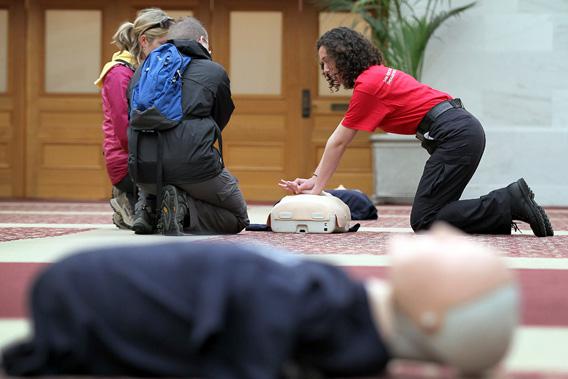This week, an emergency dispatcher in Bakersfield, Calif., frantically urged a caller to administer CPR to an 87-year-old female nursing home resident who wasn’t breathing. The caller, who identified herself as a nurse at the home, refused, citing the facility’s protocol against staff administering CPR. By the time emergency responders arrived, the resident had no pulse, and she died at a nearby hospital. The incident has prompted California law enforcement and the media to examine the legal and ethical implications of the nursing home’s policies. It also raises the question: Can you get in trouble for performing life-saving acts? And are you in hot water if you don’t help?
It depends on the state and country you are in. There is no one federal law governing the issue. Under the 2000 Federal Cardiac Arrest Survival Act, Congress gave immunity from civil damages to people administering CPR or an automatic external defibrillator, with exceptions in cases of gross negligence or willful misconduct. All states have Good Samaritan laws that grant some immunity protection for those performing CPR and an AED (again with restrictions) but they vary. Minnesota and Vermont require bystanders at an emergency to provide reasonable assistance, such as calling 911. Not assisting in Minnesota can land you a petty misdemeanor, and in Vermont a fine of up to $100. California, Nevada, and a few other states have contemplated amending their Good Samaritan laws to include a duty to assist. In some European countries and elsewhere, failing to help someone in need is a criminal offense.
A bystander providing CPR immediately after sudden cardiac arrest can double or triple a victim’s chance of survival, according to the American Heart Association. Only 32 percent of cardiac arrest victims, however, receive CPR from a bystander. A slew of complex legal, moral, ethical, and behavioral factors prevent more people from performing CPR. A series of surveys and focus groups conducted by the San Francisco Department of Public Health in 1996 found the top reason why bystanders don’t perform CPR is concern about their personal safety, according to John Brown, medical director of the San Francisco Emergency Medical Services Agency. “They’re worried the person is faking it—maybe they’ll get mugged … or that they’re going to hurt themselves bending over,” Brown says. The next two reasons are that people are worried they would hurt the injured person through applying CPR techniques such as chest compression, and they’re afraid of not being good enough at the technique. Catching an infectious disease is another reason why bystanders usually don’t stop to help, Brown says, despite the fact that using a shirt tail or a scarf can create a barrier between lips that provides some protection. Another reason is they’re afraid they’ll be sued. “There is no legal obligation for a bystander to help an injured person,” says Brown. “They can just walk by; it’s up to that individual.”
Seattle implemented a Medic One System recently in which citizens are trained to be active participants by recognizing when a fellow citizen needs medical care, calling 911, and assisting until emergency responders arrive. Results of community training and education are paying off. Nationally, only 10 percent of bystanders administer CPR. But such programs have increased the rate of bystander participation using compression-only CPR by 20 percent to 30 percent, according to Brown, citing statistics from the Centers for Disease Control’s Cardiac Arrest Registry to Enhance Survival. The rate of survival in the case of cardiac arrest outside a hospital is 8 percent in the United States. “If you’ve a cardiac arrest in Seattle, your chances of walking out of the hospital are close to 56 percent,” says Brown.
Got a question about today’s news? Ask the Explainer.
